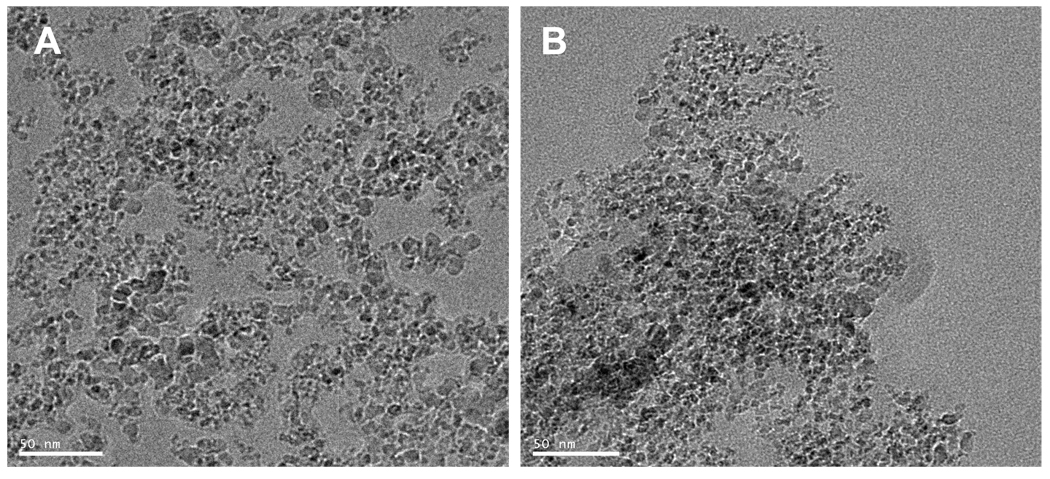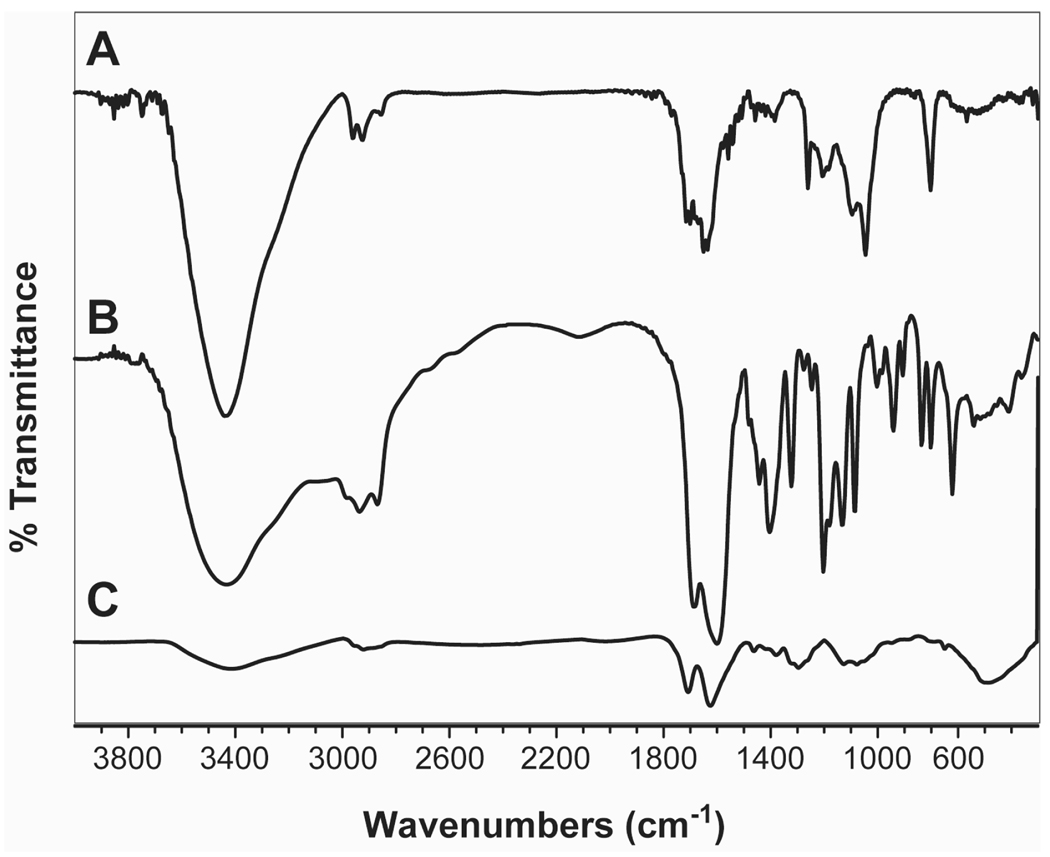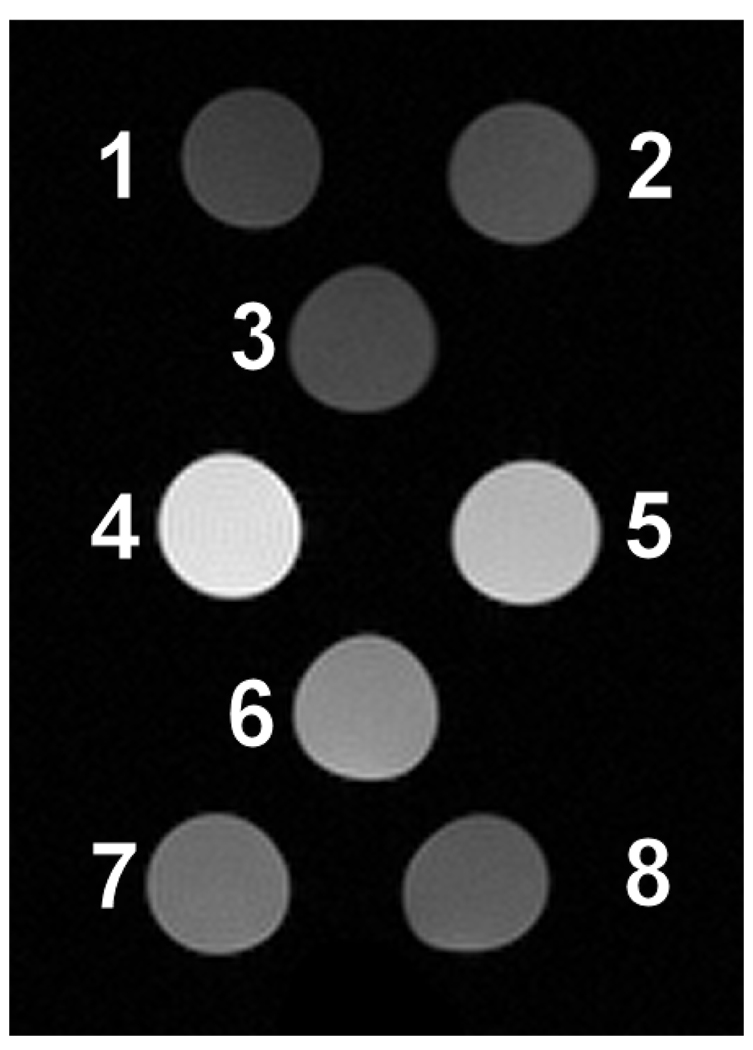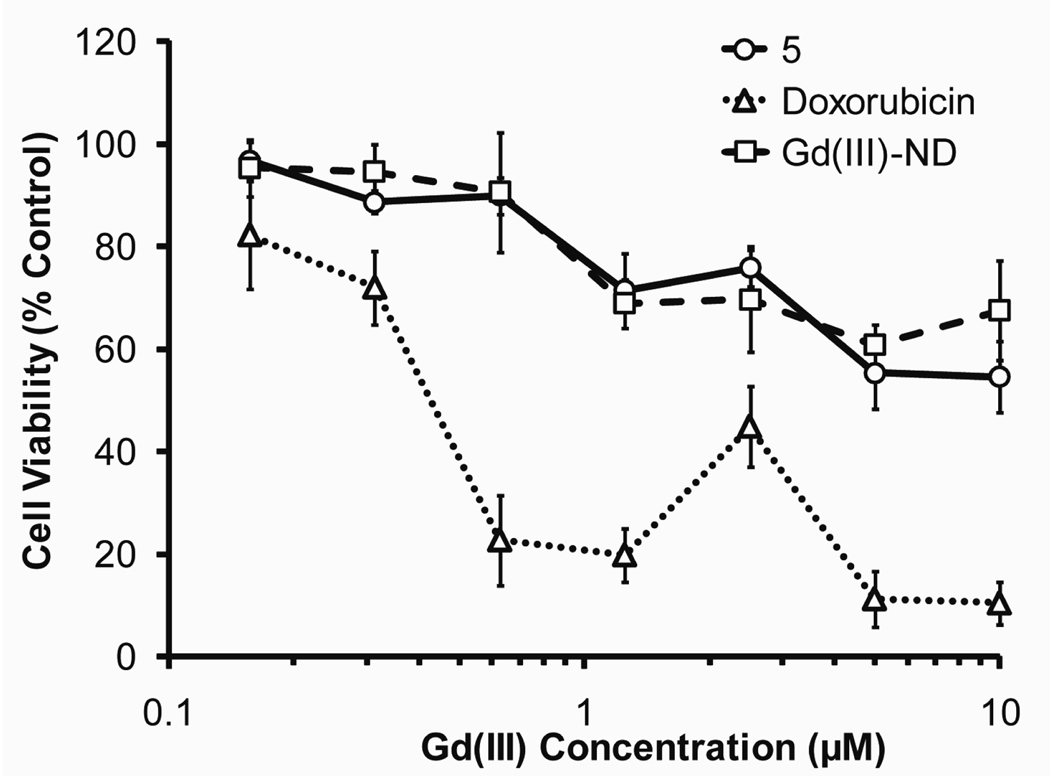Abstract
A Gd(III)-nanodiamond conjugate [Gd(III)-ND] was prepared and characterized, enabling detection of nanodiamonds by MR imaging. The Gd(III)-ND particles significantly reduced the T1 of water protons with a per-Gd(III) relaxivity of 58.82 ± 1.18 mM−1s−1 at 1.5 Tesla (60 MHz). This represents a tenfold increase compared to the monomer Gd(III) complex (r1 = 5.42 ± 0.20 mM−1s−1) and is among the highest per-Gd(III) relaxivities reported.
Multifunctional nanomaterials can be modified with specific biomolecules to increase drug loading capacity and target specific proteins, DNA sequences, and other macromolecular structures.1–5 However, one common limitation of nanoparticle applications in clinical settings is the difficulty of tracking nanoparticle localization and movement in vivo. Consequently, development of techniques for facile and effective labeling of nanoparticles with imaging agents would greatly improve the utility of nanoparticle systems.
In recent years, significant interest has been placed on carbon-based nanomaterials such as fullerenes and nanotubes for biological applications (biosensors, drug delivery) due to their physical, chemical, and biological properties.6–14 However, the biocompatibility of these compounds remains in question.15–17 Diamond-based nanoparticles have gained attention as an alternative carbon nanomaterial due to their excellent biocompatibility, which may be due in part to lower induction of cellular oxidative stress than is observed with other carbon nanomaterials.18–21 Exposure to detonation nanodiamonds did not result in a significant loss of cell viability in a variety of cell types (MTT assay and luminescent ATP production).22 Nanodiamond powder-based particles (2–8 nm in diameter) generated by detonation techniques have been shown to disperse in aqueous solutions.23, 24 Due to the extreme synthetic conditions (diamond detonation followed by treatment with oxidizing acids), the surface of a nanodiamond particle is coated with a variety of functional groups allowing for chemical modification.25, 26 For example, nanodiamonds have been shown to adsorb proteins and act as chemotherapeutic drug carriers.27–30
Although advances are being made in covalent and noncovalent modification of the nanodiamond surface, imaging of nanodiamond particles has largely centered on optical imaging with fluorescence spectroscopy.19, 20, 31 Ion beam irradiation has been used to form fluorescent centers with red and green emission visible at the cellular level.19, 20 Blue fluorescent nanodiamonds (5 nm in diameter) have been produced by covalent attachment of octadecylamine (ODA) to the carboxylate groups of the nanodiamond surface.31 While these fluorescent nanodiamonds provide an alternative to toxic quantum dots, they suffer from the similar limitations in tissue penetration as other optical imaging techniques, restricting their use to primarily histological applications. To our knowledge, there are no published reports of nanodiamonds being visualized by other imaging technologies.
Magnetic resonance imaging (MRI) is a noninvasive technique that can be used to obtain tomographic images of opaque organisms.32, 33 In comparison to other imaging techniques such as x-ray or PET, MRI requires no ionizing radiation while producing images with high spatial and temporal resolution, excellent soft tissue contrast, and deep tissue penetration.32 Images are based on the 1H NMR signal of water with signal intensities proportional to the relaxation rates of the nuclear spins. Different concentrations and microenvironments of water in different tissues result in image contrast.
Contrast agents are used to enhance the local signal intensity in cells and tissues that are magnetically similar but histologically distinct. Gd(III) complexes are used due to their seven unpaired electrons and symmetrical S ground state.34 Such agents consist of the paramagnetic metal species with one or more coordination sites available for water to interact with the unpaired electrons of the Gd(III) ion, resulting in a decreased T1 (longitudinal relaxation time).32, 34 The efficiency of a contrast agent to reduce T1 of water protons is referred to as the relaxivity, r1 (mM−1s−1), and defined by Equation 1.32, 34
| (1) |
We selected covalent modification of the nanodiamond surface for attachment of Gd(III) complexes to produce nanodiamonds detectable by MR imaging. An amine functionalized Gd(III) complex with a six carbon linker was synthesized and characterized to peptide couple to the carboxylic acid groups on the nanodiamond surface (5, Scheme 1). Synthesis of the Gd(III) chelate was initiated by reacting 6-amino-1-hexanol with di(tert-butyl) dicarbonate to give the Boc protected amine (2) in high yield. The alcohol was converted to the bromide (3) with bromine in the presence of triphenylphosphine and triethylamine (TEA). Alkylation of the secondary amino group of DO3A tris-tert-butyl ester with the protected amine gave (4). Global deportation with trifluoroacetic acid (TFA) and triethylsilane and subsequent reaction with Gd(III) chloride at pH 6.5 gave the metallated complex. The crude reaction material was purified by reverse phase high performance liquid chromatography (RP-HPLC) and the collected fractions were freeze dried to give the metallated compound (5).
Scheme 1.
Synthesis of an amine-functionalized Gd(III) contrast agent (5) for attachment to the nanodiamond surface
An aqueous stock (10 mg/mL) of nanodiamond particles was generated using previously described methods.30 The Gd(III) complex was peptide coupled to the carboxy-functionalized nanodiamond (1 mg/mL) using a ten-fold excess of 1-ethyl-3-[3-dimethylaminopropyl]carbodiimide hydrochloride (EDC) and N-hydroxysulfosuccinimide (sulfo-NHS) in a 0.1 M HEPES, 0.1 M NaCl buffer, pH 7.0 (Scheme 2). The Gd(III)-nanodiamond conjugate [Gd(III)-ND] was pelleted and the supernatant decanted. Excess 5 was separated from Gd(III)-ND through a cycle of resuspensions in water and pelleting of Gd(III)-ND. The Gd(III) concentrations of these washes were analyzed by inductively coupled plasma mass spectrometry (ICP-MS), showing that four washes were sufficient to relieve excess Gd(III) reagent (Supporting Information, Figure S1). Nonspecific interactions between 5 and the ND surface appear minimal (Supporting Information). After the final wash, Gd(III)-ND was resuspended in 5 mL of water (1mg ND/mL).
Scheme 2.
Conjugation of the Gd(III) contrast agent (5) to the nanodiamond surface
ICP-MS analysis showed 48 ± 3 µM of Gd(III) adhered to nanodiamonds per 1 mg/mL nanodiamond reaction. The majority of 5 remained in the reaction supernatant. Transmission electron microscopy (TEM) images of the nanodiamonds before and after reaction suggest the overall integrity of the individual nanodiamonds is retained but there is greater clustering after conjugation to 5 (Figure 1). Modification of the nanodiamond surface groups was investigated by Fourier transform infrared spectroscopy (FTIR) (Figure 2A). The FTIR spectra of the unmodified nanodiamonds and 5 are shown for comparison (Figure 2B, 2C)
Figure 1.
TEM images of the nanodiamonds before (A) and after conjugation (B) to the Gd(III) contrast agent, 5. The scale bars are 50 nm.
Figure 2.
FTIR spectra of the modification of the nanodiamond surface upon conjugation of the amine functionalized Gd(III) complex: (A) Gd(III)-ND, (B) 5, (C) unmodified nanodiamonds
MR imaging of three sets of Gd(III)-ND was performed with Gd(III) concentrations ranging from 5 µM to 48 µM (Figure 3). The intense signal of Gd(III)-ND was clearly visualized at the highest concentration of Gd(III) (48 µM), with a contrast to noise ratio (CNR) versus water of 142. Even at the lowest concentration of Gd(III) imaged (5 µM), Gd(III)-ND is measurably brighter than water; the CNR versus water was 25, well above the detection limit of the human eye.
Figure 3.
MR images of nanodiamond samples. 1: water, 2: 1 mg/mL undecorated ND, 3: undecorated ND + coupling reagents, 4: 48 µM Gd(III), 5: 38 µM Gd(III), 6: 22 µM Gd(III), 7: 10 µM Gd(III), 8: 5 µM Gd(III)
T1 measurements were obtained on six different concentrations of Gd(III)-ND at 37 °C in water at 1.5 T. A 48 µM Gd(III) sample of Gd(III)-ND decreased the average longitudinal relaxation time of environmental water protons 10-fold with respect to unfunctionalized nanodiamonds (Table 1). 1/T1 increased linearly with increasing concentrations of Gd(III)-ND with a slope corresponding to a relaxivity of 58.82 ± 1.18 mM−1s−1 (Table 2). This is significantly higher than clinical Gd(III) contrast agents, Gd-DTPA and Gd-DOTA with relaxivity values of 3.8 mM−1s−1 and 3.5 mM−1s−1, respectively.34
Table 1.
Average T1 (longitudinal relaxation time) and corresponding Gd(III) concentrations for water, the free Gd(III) complex 5, unmodified nanodiamonds, and Gd(III)-ND. A sharp decrease in T1 is observed upon conjugation of 5 to the nanodiamond surface [Gd(III)-ND].
| Sample | [Gd] (mM) | T1(ms) |
|---|---|---|
| Water | 0.000 | 3820 ± 10 |
| 5 | 1.751 | 105.7 ± 0.6 |
| 5 | 0.128 | 1253 ± 27 |
| ND (1mg/mL) | 0.001 | 3103 ± 114 |
| Gd(III)-ND | 0.048 | 319 ± 11 |
Table 2.
Gd(III) ionic relaxivity values for 5 and Gd(III)-ND at 1.5 T, 37 °C
| Complex | r1 (mM−1s−1) |
|---|---|
| 5 | 5.42 ± 0.20 |
| Gd(III)-ND | 58.82 ± 1.18 |
Solomon–Bloembergen–Morgan Theory summarizes the parameters that can be manipulated to increase the relaxivity of a given Gd(III) contrast agent. These include q, the number of water molecules coordinated to each Gd(III) center; τr, the rotational correlation time; and τm, the mean residence lifetime of the coordinated waters.35, 36 Small molecule Gd(III) agents have a τr on the order of tens of picoseconds; the optimal τr to maximize relaxivity at 1.5 T is estimated to be several nanoseconds.37, 38
Optimization of τr has been approached from conjugation of Gd(III) complexes to nanoparticles, proteins, and peptides with the additional molecular weight of the appendage slowing the rotation of the agent.2, 37, 39–46 For example, MS-325 is a blood pool contrast agent and has been shown to have a 9-fold increase in relaxivity upon binding human serum albumin (HSA).37 We are conjugating our complexes to a nanoparticle significantly higher in molecular weight than a protein resulting in a longer rotational correlation time and a larger increase in relaxivity.
Clustering of the modified nanodiamond particles could be a factor in the observed measurements (Supporting Information, Table S1). Hydrodynamic sizes of the nanodiamonds and Gd(III)-ND as determined by dynamic light scattering (DLS) suggest that Gd(III)-ND forms small clusters after conjugation of the Gd(III) complexes. Before conjugation, the nanodiamonds are approximately 21 nm with no observable concentration dependence in hydrodynamic size. The hydrodynamic size of Gd(III)-ND was seen to decrease (128 ± 14 nm, 6 µM Gd to 55 ± 4 nm, 0.2 µM Gd) upon dilution and ultrasonication, suggesting fragmentation of the Gd(III)-ND clusters. 55–60 nm appears to be a lower limit at dilute concentrations for the hydrodynamic size of Gd(III)-ND. Aggregation has been observed to contribute to the increased relaxivities of Gd(III)-fullerene contrast agents in aqueous solution.47, 48 However, unlike Gd(III)-fullerenes, the nanodiamonds do not sequester the paramagnetic metal allowing direct interaction of the bulk water with the Gd(III) complex. This permits both inner sphere and outer sphere relaxation mechanisms to contribute to the observed relaxivity.
Previous studies using differential scanning calorimetric analysis (DSC) have shown that strong electrostatic potentials on the nanodiamond facets result in a surface-mediated attraction towards surrounding water molecules, effectively creating a nanophase of water at the nanodiamond-solvent interface.49 The potent hydration observed has thus been proposed as a mechanism that drives gelation of the nanodiamonds towards a hydrogel state. Nanodiamond facet electrostatic conditions can be differentially charged depending upon the plane being addressed. For example, [111] facets display negatively charged electrostatic fields while [100] facets display positively charged electrostatic fields. Given these conditions, water molecules orient in clusters with opposing alignments/dipoles that are highly attracted to each other, significantly enhancing the adhesion of a robust and continuous hydration layer surrounding the particle surface.49 The combination of direct interaction of the water nanophase with the paramagnetic metal and the size of the nanodiamond clusters (130 nm - 55 nm) may help to explain the high relaxivity of the system.
With diamond-based nanoparticles considered as an attractive alternative carbon nanomaterial due to their high biocompatibility, the effect of Gd(III)-ND on cell viability, metabolic activity, and cytotoxicity using multiple mammalian cell lines was tested. Preliminary results using human ovary adenocarcinoma (SKOV-3) cells show 5 and Gd(III)-ND conjugates do not significantly decrease cell viability compared to doxorubicin (a known, potent cytotoxic agent, Figure 4). There is, however, a decrease in overall cell viability at 24 h for both 5 and Gd(III)-ND at Gd(III) incubation concentrations higher than 1.0 µM [0.0250 mg/mL Gd(III)-ND].
Figure 4.
Cell viability (using an MTT assay) of SKOV-3 human ovary adenocarcinoma cells after 24 h incubation with various concentrations of Gd(III)-ND (squares), 5 (circles), and doxorubicin (triangles) as a positive control. Cell viability is represented as the percent absorbance with respect to control cells (those incubated with media alone). All conditions were done in triplicate with error bars representing ± one standard deviation of the mean. 40 µM Gd(III) is equivalent to ~ 1.0 mg/mL Gd(III)-ND.
To determine the effect of nanodiamond incubation time on cell metabolic activity and cytotoxicity [glucose 6-phosphate dehydrogenase (G6PD) leakage], NIH/3T3 and HeLa cells were cultured. These cell lines were chosen because they are slightly more robust and have higher metabolic activity and G6PD leakage (compared to SKOV-3 cells), a requirement to conduct these assays. As shown in Figure 5A, overall cell metabolism is comparable to control levels at ≤ 0.250 mg/mL Gd(III)-ND in NIH/3T3 cells, but significantly decreases at 0.500 mg/mL Gd(III)-ND. There was no significant decrease in the metabolic activity of HeLa cells (compared to control 1) using the same conditions. A test for cytotoxicity revealed Gd(III)-ND has no significant effect on cytotoxicity compared to unmodified nanodiamonds (Figure 5B) except in NIH/3T3 cells at 0.500 mg/mL Gd(III)-ND after 24 h incubation. Gd(III)-ND conjugates exhibit relatively low cytotoxicity with IC50 values higher than 0.500 mg/mL Gd(III)-ND (according to three separate assays and three cell lines). These results show the addition of a Gd(III)-based contrast agent to the nanodiamond surface does not have a significant effect on overall cell viability.
Figure 5.
Metabolic activity (A, Vybrant® metabolic activity assay kit) and cytotoxicity (B, Vybrant® cytotoxicity assay kit) of NIH/3T3 and HeLa cells after 24, 4.0, and 1.0 h incubations with various concentrations of Gd(III)-ND. Metabolic activity is represented as the percent fluorescence with respect to control cells (those incubated with media alone). Cytotoxicity is represented as the percent fluorescence with respect to lysed cells incubated with media alone. Control 1 are cells incubated with media alone and control 2 are cells incubated with 0.500 mg/mL NDs [no Gd(III)] for 24 h. All conditions were done in triplicate with error bars representing ± one standard deviation of the mean. 40 µM Gd(III) is equivalent to ~ 1.0 mg/mL Gd(III)-ND.
Utilizing the inherent surface chemistry of detonation nanodiamonds, an amine-functionalized Gd(III) complex was covalently bound allowing visualization of nanodiamond particles by MR imaging. The relaxivity of the Gd(III) contrast agent increased nearly 10-fold in comparison to the free agent (5) upon conjugation to the nanodiamond platform. This enhanced contrast is clearly seen in the MR images of modified and unmodified species.
Current efforts are focused on the biodistribution of Gd(III)-ND in vivo, applications of Gd(III)-ND at the biomaterials interface, and on studying the field dependence of the Gd(III)-ND relaxivity. Rotational correlation time (τr) is influenced by the strength of the magnetic field, with the theoretical maximum relaxivity decreasing at higher field strengths.38, 50, 51 Further study will include relaxivity measurements at 9.4 T to monitor relaxometric decline. Variation in the linker length of the amino-alkane to the macrocyclic chelate will be explored to manipulate the extent to which hindrance of the chelate rotation plays a role in the increased relaxivity.
Supplementary Material
ACKNOWLEDGMENT
The authors thank A. L. Eckermann and A. Ott for experimental assistance and valuable discussion, R. Lam and M. Chen for nanodiamond preparation, and C. Mirkin for use of the fluorescence plate reader in cell viability analysis. We thank the Northwestern University Integrated Molecular Structure Education and Research Center (IMSERC); a description of the facility and full funding disclosure can be found at http://pyrite.chem.northwestern.edu/analyticalserviceslab/asl.htm. MR imaging was performed on instruments supported by NIH/NCRR Grant S10 RR15685-01. This work was funded in part by the National Science Foundation / National Institute of Health under Grant No. NSF CHE-9871268, the National Cancer Institute Center for Cancer Nanotechnology Excellence initiative at Northwestern University Award No. U54CA119341, NSF CAREER Award (CMMI-0846323), NSF grants CMMI-0856492 and DMI-0327077, V Foundation for Cancer Research V Scholars Award, and the Wallace H. Coulter Foundation Early Career Award in Translational Research.
Footnotes
SUPPORTING INFORMATION AVAILABLE
Supporting material includes a complete description of the materials and methods used in experimentation. Additionally, an ICP-MS analysis of the washing procedures for the Gd(III)-nanodiamond conjugates is presented. After removal of the reaction supernatant, the particles underwent a cycle of pelleting by centrifugation and resuspension in water. ICP-MS was performed on the reaction supernatant and each of the washes to determine Gd(III) content. By the third wash, Gd(III) content was seen to reach a minimum. Four washes in total were collected before the conjugates were resuspended in a 1 mg/mL solution. An analysis of the dynamic light scattering data is included regarding the hydrodynamic size for nanodiamonds and Gd(III)-ND. This material is available free of charge via the Internet at http://pubs.acs.org.
REFERENCES
- 1.Christof MN. Angew. Chem., Int. Ed. 2001;40:4128–4158. [Google Scholar]
- 2.Endres PJ, Paunesku T, Vogt S, Meade TJ, Woloschak GE. J. Am. Chem. Soc. 2007;129:15760–15761. doi: 10.1021/ja0772389. [DOI] [PubMed] [Google Scholar]
- 3.Allen TM, Cullis PR. Science. 2004;303:1818–1822. doi: 10.1126/science.1095833. [DOI] [PubMed] [Google Scholar]
- 4.Rao CNR, Cheetham AK. J. Mater. Chem. 2001;11:2887–2894. [Google Scholar]
- 5.Caruso F. Adv. Mater. 2001;13:11–22. [Google Scholar]
- 6.Shinohara H. Rep. Prog. Phys. 2000;63:843–892. [Google Scholar]
- 7.Nakamura E, Isobe H. Acc. Chem. Res. 2003;36:807–815. doi: 10.1021/ar030027y. [DOI] [PubMed] [Google Scholar]
- 8.Sun Y-P, Fu K, Lin Y, Huang W. Acc. Chem. Res. 2002;35:1096–1104. doi: 10.1021/ar010160v. [DOI] [PubMed] [Google Scholar]
- 9.Lin Y, Taylor S, Li H, Fernando KAS, Qu L, Wang W, Gu L, Zhou B, Sun Y-P. J. Mater. Chem. 2004;14:527–541. [Google Scholar]
- 10.Bianco A, Kostarelos K, Partidos CD, Prato M. Chem. Commun. (Cambridge, U. K.) 2005:571–577. doi: 10.1039/b410943k. [DOI] [PubMed] [Google Scholar]
- 11.Chen X, Tam UC, Czlapinski JL, Lee GS, Rabuka D, Zettl A, Bertozzi CR. J. Am. Chem. Soc. 2006;128:6292–6293. doi: 10.1021/ja060276s. [DOI] [PubMed] [Google Scholar]
- 12.Bianco A, Prato M. Adv. Mater. (Weinheim, Ger.) 2003;15:1765–1768. [Google Scholar]
- 13.Manna SK, Sarkar S, Barr J, Wise K, Barrera EV, Jejelowo O, Rice-Ficht AC, Ramesh GT. Nano Lett. 2005;5:1676–1684. doi: 10.1021/nl0507966. [DOI] [PMC free article] [PubMed] [Google Scholar]
- 14.Lacerda L, Bianco A, Prato M, Kostarelos K. Adv. Drug Delivery Rev. 2006;58:1460–1470. doi: 10.1016/j.addr.2006.09.015. [DOI] [PubMed] [Google Scholar]
- 15.Smart SK, Cassady AI, Lu GQ, Martin DJ. Carbon. 2006;44:1034–1047. [Google Scholar]
- 16.Jia G, Wang H, Yan L, Wang X, Pei R, Yan T, Zhao Y, Guo X. Environ. Sci. Technol. 2005;39:1378–1383. doi: 10.1021/es048729l. [DOI] [PubMed] [Google Scholar]
- 17.Warheit DB, Laurence BR, Reed KL, Roach DH, Reynolds GAM, Webb TR. Toxicol Sci. 2004;77:117–125. doi: 10.1093/toxsci/kfg228. [DOI] [PubMed] [Google Scholar]
- 18.Narayan RJ, Wei W, Jin C, Andara M, Agarwal A, Gerhardt RA, Shih C-C, Shih C-M, Lin S-J, Su Y-Y, Ramamurti R, Singh RN. Diamond Relat. Mater. 2006;15:1935–1940. [Google Scholar]
- 19.Yu S-J, Kang M-W, Chang H-C, Chen K-M, Yu Y-C. J. Am. Chem. Soc. 2005;127:17604–17605. doi: 10.1021/ja0567081. [DOI] [PubMed] [Google Scholar]
- 20.Fu C-C, Lee H-Y, Chen K, Lim T-S, Wu H-Y, Lin P-K, Wei P-K, Tsao P-H, Chang H-C, Fann W. Proc. Natl. Acad. Sci. U. S. A. 2007;104:727–732. doi: 10.1073/pnas.0605409104. [DOI] [PMC free article] [PubMed] [Google Scholar]
- 21.Schrand AM, Dai L, Schlager JJ, Hussain SM, Osawa E. Diamond Relat. Mater. 2007;16:2118–2123. [Google Scholar]
- 22.Schrand AM, Huang H, Carlson C, Schlager JJ, Osawa E, Hussain SM, Dai L. J. Phys. Chem. B. 2007;111:2–7. doi: 10.1021/jp066387v. [DOI] [PubMed] [Google Scholar]
- 23.Greiner NR, Phillips DS, Johnson JD, Volk F. Nature (London) 1988;333:440–442. [Google Scholar]
- 24.Krüger A, Kataoka F, Ozawa M, Fujino T, Suzuki Y, Aleksenskii AE, Vul AY, Osawa E. Carbon. 2005;43:1722–1730. [Google Scholar]
- 25.Krueger A. Chem. - Eur. J. 2008;14:1382–1390. doi: 10.1002/chem.200700987. [DOI] [PubMed] [Google Scholar]
- 26.Huang H, Pierstorff E, Osawa E, Ho D. ACS Nano. 2008;2:203–212. doi: 10.1021/nn7000867. [DOI] [PubMed] [Google Scholar]
- 27.Huang LCL, Chang H-C. Langmuir. 2004;20:5879–5884. [PubMed] [Google Scholar]
- 28.Chung PH, Perevedentseva E, Tu JS, Chang CC, Cheng CL. Diamond Relat. Mater. 2006;15:622–625. [Google Scholar]
- 29.Nguyen TT-B, Chang H-C, Wu VW-K. Diamond Relat. Mater. 2007;16:872–876. [Google Scholar]
- 30.Huang H, Pierstorff E, Osawa E, Ho D. Nano Lett. 2007;7:3305–3314. doi: 10.1021/nl071521o. [DOI] [PubMed] [Google Scholar]
- 31.Mochalin VN, Gogotsi Y. J. Am. Chem. Soc. 2009;131:4594–4595. doi: 10.1021/ja9004514. [DOI] [PubMed] [Google Scholar]
- 32.Merbach A, Toth E. The Chemistry of Contrast Agents in Medical Magnetic Resonance Imaging. New York: John Wiley & Sons, Ltd.; 2001. [Google Scholar]
- 33.Winter PM, Caruthers SD, Wickline SA, Lanza GM. Curr. Cardiol. Rep. 2006;8:65–69. doi: 10.1007/s11886-006-0013-2. [DOI] [PubMed] [Google Scholar]
- 34.Caravan P, Ellison JJ, McMurry TJ, Lauffer RB. Chem. Rev. 1999;99:2293–2352. doi: 10.1021/cr980440x. [DOI] [PubMed] [Google Scholar]
- 35.Solomon I. Phys. Rev. 1955;99:559. [Google Scholar]
- 36.Bloembergen N, Morgan LO. J. Chem. Phys. 1961;34:842–850. [Google Scholar]
- 37.Caravan P, Cloutier NJ, Greenfield MT, McDermid SA, Dunham SU, Bulte JWM, Amedio JC, Looby RJ, Supkowski RM, Horrocks WD, McMurry TJ, Lauffer RB. J. Am. Chem. Soc. 2002;124:3152–3162. doi: 10.1021/ja017168k. [DOI] [PubMed] [Google Scholar]
- 38.Caravan P, Farrar CT, Frullano L, Uppal R. Contrast Media Mol. Imaging. 2009;4:89–100. doi: 10.1002/cmmi.267. [DOI] [PMC free article] [PubMed] [Google Scholar]
- 39.Briley-Saebo KC, Geninatti-Crich S, Cormode DP, Barazza A, Mulder WJM, Chen W, Giovenzana GB, Fisher EA, Aime S, Fayad ZA. J. Phys. Chem. B. 2009;113:6283–6289. doi: 10.1021/jp8108286. [DOI] [PMC free article] [PubMed] [Google Scholar]
- 40.Datta A, Hooker JM, Botta M, Francis MB, Aime S, Raymond KN. J. Am. Chem. Soc. 2008;130:2546–2552. doi: 10.1021/ja0765363. [DOI] [PubMed] [Google Scholar]
- 41.Bull SR, Guler MO, Bras RE, Meade TJ, Stupp SI. Nano Lett. 2004;5:1–4. doi: 10.1021/nl0484898. [DOI] [PubMed] [Google Scholar]
- 42.Bull SR, Guler MO, Bras RE, Venkatasubramanian PN, Stupp SI, Meade TJ. Bioconjugate Chem. 2005;16:1343–1348. doi: 10.1021/bc050153h. [DOI] [PubMed] [Google Scholar]
- 43.Song Y, Kohlmeir EK, Meade TJ. J. Am. Chem. Soc. 2008;130:6662–6663. doi: 10.1021/ja0777990. [DOI] [PMC free article] [PubMed] [Google Scholar]
- 44.Major JL, Meade TJ. Acc. Chem. Res. 2009;42:893–903. doi: 10.1021/ar800245h. [DOI] [PMC free article] [PubMed] [Google Scholar]
- 45.Zhang Z, Greenfield MT, Spiller M, McMurry TJ, Lauffer RB, Caravan P. Angew. Chem., Int. Ed. 2005;44:6766–6769. doi: 10.1002/anie.200502245. [DOI] [PubMed] [Google Scholar]
- 46.Mulder WJM, Koole R, Brandwijk RJ, Storm G, Chin PTK, Strijkers GJ, de Mello Donega C, Nicolay K, Griffioen AW. Nano Lett. 2005;6:1–6. doi: 10.1021/nl051935m. [DOI] [PubMed] [Google Scholar]
- 47.Sitharaman B, Bolskar RD, Rusakova I, Wilson LJ. Nano Lett. 2004;4:2373–2378. [Google Scholar]
- 48.Toth E, Bolskar RD, Borel A, Gonzalez G, Helm L, Merbach AE, Sitharaman B, Wilson LJ. J. Am. Chem. Soc. 2004;127:799–805. doi: 10.1021/ja044688h. [DOI] [PubMed] [Google Scholar]
- 49.Korobov MV, Avramenko NV, Bogachev AG, Rozhkova NN, Ōsawa E. J. Phys. Chem. C. 2007;111:7330–7334. [Google Scholar]
- 50.Caravan P. Chem. Soc. Rev. 2006;35:512–523. doi: 10.1039/b510982p. [DOI] [PubMed] [Google Scholar]
- 51.Rohrer M, Bauer H, Mintorovitch J, Requardt M, Weinmann H-J. Invest. Radiol. 2005;40:715–724. doi: 10.1097/01.rli.0000184756.66360.d3. [DOI] [PubMed] [Google Scholar]
Associated Data
This section collects any data citations, data availability statements, or supplementary materials included in this article.









